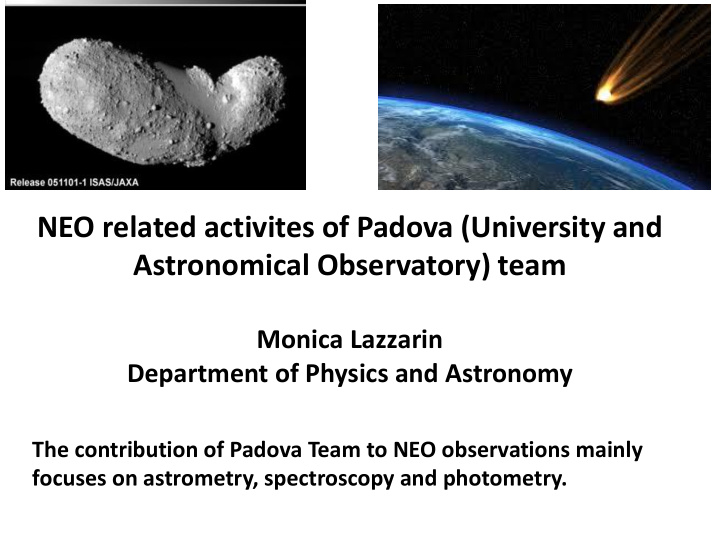



NEO related activites of Padova (University and Astronomical Observatory) team Monica Lazzarin Department of Physics and Astronomy The contribution of Padova Team to NEO observations mainly focuses on astrometry, spectroscopy and photometry.
Padova Team Monica Lazzarin - Dip. di Fisica e Astronomia - Univ. di Padova - Ricercatore monica.lazzarin@unipd.it Ivano Bertini - Dip. di Fisica e Astronomia - Univ. di Padova - Assegnista Ivano.bertini@unipd.it Fiorangela La Forgia - Dip. di Fisica e Astronomia - Univ. di Padova – Assegnista fiorangela.laforgia@unipd.it Maurizio Pajola - Dip. di Fisica e Astronomia - Univ. di Padova – Assegnista maurizio.pajola@unipd.it Paolo Ochner – Osservatorio Astron. Padova – Technician Paolo.ochner@oapd.inaf.it Alessandro Siviero – Dip. di Fisica e Astronomia- Univ. Di Padova – Technician Alessandro.siviero@unipd.it
Previous experience and obtained results • SINEO project (Spectroscopic Investigation of Near Earth Objects): a large spectroscopic data base with about 200 spectra of NEOs in the visible and Near Infrared region (0.4-2.5 micron) partly published and not yet completely analyzed. 150 spectra in the visible and 90 in the NIR. Some examples: S C
• Taxonomic classification: needed for estimate the composition of the objects. Obtained almost all the taxonomic classes found in the MB that confirms NEOs variegate origin. The use of the Principal Component Analysis confirms the taxonomic classification obtained. C- X- PCA: performed using SMASS II data (Binzel 2002). Our data distribute in the same clusters defined by S- SMASS II data.
• Comparison of NEO spectra with those of about 900 meteorites taken from RELAB catalog. Most meterorites has not a clear origin. Found that 38% of NEOs have a meteoritic analogue; all C-types have a Carbonaceous Chondrite analogue and 24% of S-types have an Ordinary Chondrite analogue. A first conclusion is that NEOs are the principal parent bodies of meteorites that fall on the Earth. Most part of the investigated S-types NEOs does not fit with any meteorite: their spectra are typically redder
• Study of space weathering The S-type NEOs that do not match with any meteorite are typically redder than the reddest OC meteorites and we conclude that this is due to space weathering effects Laboratory experiments made in collaboration with Catania observatory on OC meteorites indicate that ion bombardment of OC meteorites is able to mimic SW effects on S-type objects due to solar wind
• Peculiar objects: dead/dormant comets, family asteroids, rare taxonomic types… We have found some peculiar objects: the spectra of four V-type objects very similar to Vesta. Then the spectrum of a NEO probably belonging to the rare R-class. The spectra of 2 objects of primitive composition that could be of cometary origin. In fact they also have a Tj typically cometary and a high probability to come from the JFC channel. 2/1/2016 Italian Workshop on SSA
Tools adopted for SINEO • Observations: low resolution spectra in the spectral range 0.40 – 2.50 micron • Telescope used: ESO-NTT La Silla-Cile and TNG-La Palma-Canarias EMMI DOLORES Gr#1, D=5.9 Å /pix, Slit=5”, seeing=1” LR-R Grm3, D=2.9 Å /pix, Slit=5”, seeing=1” V=20 in T exp =1h V=20.0 in T exp =1.0h S/N=20 S/N=23 SOFI NICS GB, D=6.9 Å /pix, Slit=2”, seeing=1” Amici, D=30-100 Å /pix, Slit=2”, seeing=1” J=16 (V 17.5) in T exp =1.5h H=16.2 (V 18.0 ) in T exp =1.0h S/N=20 S/N=30 GR, D=10.2 Å /pix, Slit=2”, seeing=1” K=16 (V 18) in T exp =2.5h 2/1/2016 S/N=20
Facilities easily available at Asiago Observatory for NEO observations 1.80 m Telescope 1.22m Telescope Schmidt 67/92 2/1/2016
The 182 cm telescope Two instruments are available: a low resolution spectrograph and imager (AFOSC) and an high resolution spectrograph (Echelle). The two instruments are complementary for spectral resolution and are therefore mounted in turn at the telescope following the moon cycle (AFOSC being usually available during grey and dark time).
Schmidt 67/92 Telescope CCD TECHNICAL DATA 4049x2672 px CCD scale: 0.86 arcsec/px (unbinned); FOV: 58X38 arcmin Autoguider CCD: 657x495 pixel TC-237H Filters wheel with Johnson-Bessel BV and Cousins - RI filters (2") 2/1/2016 Italian Workshop on SSA inserted.
ADAS, Asiago-DLR Asteroid Survey Past project in collabration with DLR for the search and follow up of comets and asteroids. Performed with the Schmidt telescope equipped with a dedicated camera (station IAU codex 209) • Observing Statistics Objects observed: 3506 • New Designations: 326 • Total number of Positions measured and submitted to the MPC: 17215 • Number of Positions published by the MPC: 14929 • New orbits: 189 • Special asteroids discovered: • 3 Trojans • 1 Hilda • 1 Hungaria • Marscrossers: • 2002 AN 7 • 2002 CS • Numbered Objects: 108
Galileo telescope 1.22m equipped with a B&C spectrograph 4 gratings, dispersion from 42 Å/mm to 339 Å/mm CCD Andor iDus DU440 2048×512 pixels Spatial scale 1"/pixel
Some observations from Asiago for SSA -- Asteroid 2002 GT , 18 July 2013, target of NASA’s Epoxi mission in January 2020. A very good and first example of European collaboration under the ‘coordinating function’ of ESA’s Near -Earth Object Coordination Centre Spectra and photometric data from Asiago Observatory which allowed determination of the asteroid type (Sq), in agreement with other observations. 2/1/2016
WT1190F observation campaign: The impact in the Indian Ocean on 13 November provided an excellent opportunity to simulate the observational sequence that needs to be triggered if an actual asteroidal impactor were discovered. Astrometric data and colour data of the object as well as an extended observational coverage to investigate the possibility of long rotational periods were obtained by the Asiago Schmidt telescope from very early after discovery to less than an hour before the impact.
Recommend
More recommend